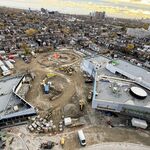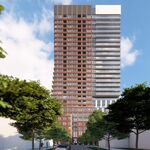From SSP- a backgrounder on the REM. Ultimately- keeping politicking out of decision making, pushing the project through cycles of optimization and piggy-backing onto larger infrastructural projects/utilizing existing infrastructures better. I bet you if they had to build a new tunnel through Mount Royal or a bridge across the St. Lawrence, REM would probably be a far less fantastic deal than it is now- credit to the Quebec Liberals.
d_jeffrey said:
Buses operating costs are about 0.99$ per km per user and trains full subsidy of about 1.21$ for the worse lines. It thus made financial sense to remove the entire Deux-Montagne line (even if it was the most profitable line).
SkyscraperPage.com's discussion forum is one of the world's most active community discussion portals for skyscraper, urbanism and building enthusiasts. Featuring coverage of the world's projects, there are topics that will appeal to the skyscraper enthusiast in everyone.
forum.skyscraperpage.com
This $1.21 figure is a telling example for how the CDPQ and their many supporters frame facts and figures: By just comparing it with the
$0.72 per passenger-km subsidy the REM's promoters will receive, one could think that the REM transports passengers at 59.5% ($0.72 divided by $1.21) of the operating costs incurred by AMT/RTM/Exo's (it's difficult to keep track of all the name changes) commuter rail network, thus saving the taxpayer $0.49 ($1.21 minus $0.72) per passenger-km. For whatever reason, the EXO's Annual Reports no longer specify cost and revenue figures per line and we'll have to resort to the 2016 AMT Annual Report, which features the following tables:
Table 1: Performance indicators of AMT network (2016)
Source:
AMT 2016 Annual Report (p.43)
Note: the figures I will use in the following tables will be "Achalandage" (ridership), "Trajet (km)" (route length), "couts d'exploitation" (operating expenses) and "recettes usagers" (revenues).
To compare, the performance indicators provided by the EXO 2018 Annual Report only include the passenger counts, which hinders any cost comparison of the current commuter rail network with the future REM:
Table 2: Performance indicators indicators of Exo network (2018)
Source:
EXO 2018 Annual Report (p.31)
At this point, it is important to note that the REM network will only replace entirely one single line (the Deux-Montagne line), while it will truncate two other services (the Saint-Jerome and Mascouche lines, which will terminate at the projected A40 station, where passengers will be forced to transfer onto the REM for the final miles into downtown Montreal) and partly overlap with the catchment areas of the remaining EXO lines: Candiac, Mont-Saint-Hillaire and most importantly: Vaudreuil-Hudson.
Therefore, to determine whether it is more cost-effective for the taxpayer to transport the existing ridership on the Deux-Montagnes lines with the existing commuter rail service or with the REM, we need to somehow estimate a per-passenger-km figure for that line. Unfortunately, the AMT Annual Report does not provide any passenger mileage data, which means we'll need to get creative, but let's start by assuming that $1.21 is the per passenger-mile for the entire AMT network:
Table 3: Estimation of passenger-km figures by assuming per passenger-km subsidy of $1.21
Compiled from:
AMT 2016 Annual Report (p.43) with "Passenger-km" figures derived by using the $1.21 per passenger-km figure (Annual subsidy divided by per passenger-km subsidy equals annual passenger-kilometre count).
Note: line length provided for the Vaudreuil-Hudson line excludes the mileage between Vaudreuil and Hudson, as it is only served by one train per day.
However, dividing the passenger-km figures we derive for the various lines by their respective ridership counts yields improbably short average trip lengths (compare second-last column in table above with the table below: for instance, 2.0 km on the Deux-Montagnes line doesn't even cover half of the distance to the first station), if we look at the station spacing of the various routes:
Table 4: Distance between the downtown termini and the subsequent stations for the various commuter rail lines in Montreal
Measured with: Google Earth
Given that there is only one line for which the estimated average trip length equals more than 1 station from its terminus, it becomes clear that the Mascouche line is the line with the worst per passenger-km figure (as also indicated by it having the lowest cost-recovery rate, as shown in Tables 1 and 3) and that that figure must be significantly smaller (than $1.21) for the other lines. If we assume that the average trip length as percentage of the respective line's route length of the Mascouche line is representative for all other lines, the per passenger-km subsidy on the Deux-Montagnes line decreases from $1.21 to $0.44 (i.e. by 64%), at which point transporting a single passenger on the Deux-Montagnes becomes pricier rather than cheaper with the REM (as we will see in more detail in Table 7):
Table 5: Estimation of passenger-km figures by assuming an average trip distance of 18.8% of total line length
Compiled from:
AMT 2016 Annual Report (p.43) with "Passenger-km" figures derived by using the $1.21 per passenger-km figure (Annual subsidy divided by per passenger-km subsidy equals annual passenger-kilometre count) for the Mascouche line and assuming the same ratio between average trip length and total line length as on the Mascouche line (i.e. 18.8%) on all other lines.
Note: line length provided for the Vaudreuil-Hudson line excludes the mileage between Vaudreuil and Hudson, as it is only served by one train per day.
However, the average trip length is still slightly inferior than the distance to Canora as the first station when traveling from Gare Centrale (5.6 km vs. 5.7 km). If we instead assume that the average distance travelled on the Mascouche line (i.e. 9.4 km) is representative for all other lines, the per passenger-km subsidy on the Deux-Montagnes line decreases even further (to $0.26, or less than one-quarter of the $1.21), at which point the REM's cost disadvantage (for the taxpayer) of transporting a single passenger on the Deux-Montagnes line increases even further:
Table 6: Estimation of passenger-km figures by assuming an average trip length of 9.4 km
Compiled from:
AMT 2016 Annual Report (p.43) with "Passenger-km" figures derived by assuming that 9.4 km (i.e. the average distance travelled on the Mascouche line, given the $1.21 per passenger-mile subsidy figure) is also the average distance travelled on all other lines.
Note: line length provided for the Vaudreuil-Hudson line excludes the mileage between Vaudreuil and Hudson, as it is only served by one train per day.
So, in summary, what effect do the difference "subsidy per passenger-km" figures have on the Deux-Montagnes line? Most obviously, a decrease of the AMT's figure of $1.21 to $0.26 turns the REM's
per passenger-km cost advantage of $0.49 to a
disadvantage of $0.46. More importantly, as (given that we know the total subsidy) a lower subsidy per passenger-km figure results in a higher passenger-km count (or average trip length figure), the REM's
per passenger cost advantage of $1.00 turns into a disadvantage of $4.33. This means that rather than reducing the operating costs of transporting the current ridership by $7.6 million (or 40%), it
increases it by $32.8 million (or a shocking 176%). Note that an average trip length of 9.43 brings you to just past the 3rd (of 11) stations when travelling from Gare Centrale towards Deux-Montagnes, which means that it is quite likely that the AMT's per passenger-km subsidy figure is even lower than $0.44, which would mean that the REM's cost disadvantage is even worse. But even at $0.26, these figures are disastrous enough for a mode (rail) which is usually characterised by economies of scale:
Table 7: Financial effect of the various per passenger-km subsidy figures on the REM's relative cost-effectiveness
Compiled from: data provided or estimated in Tables 3, 5 and 6.
Having followed this project closely from its beginning, this selective and distorted use of facts and figures is very typical of the REM project and its promoters. Trying to justify an already obscene figure of $0.72 by waving around an even bigger figure ($1.21) to justify the removal of the most cost-effective commuter line, which has a much, much lower figure just demonstrates how an honest discussion about this project and its merits and costs is obscured. The fact that AMT/RMT/exo stopped publishing the figures one needs to somewhat compare the operating costs faced by the taxpayer with those of the current commuter rail network just at the time where the REM project was revealed (April 2016), just exemplifies how this project is shielded from any due diligence.





